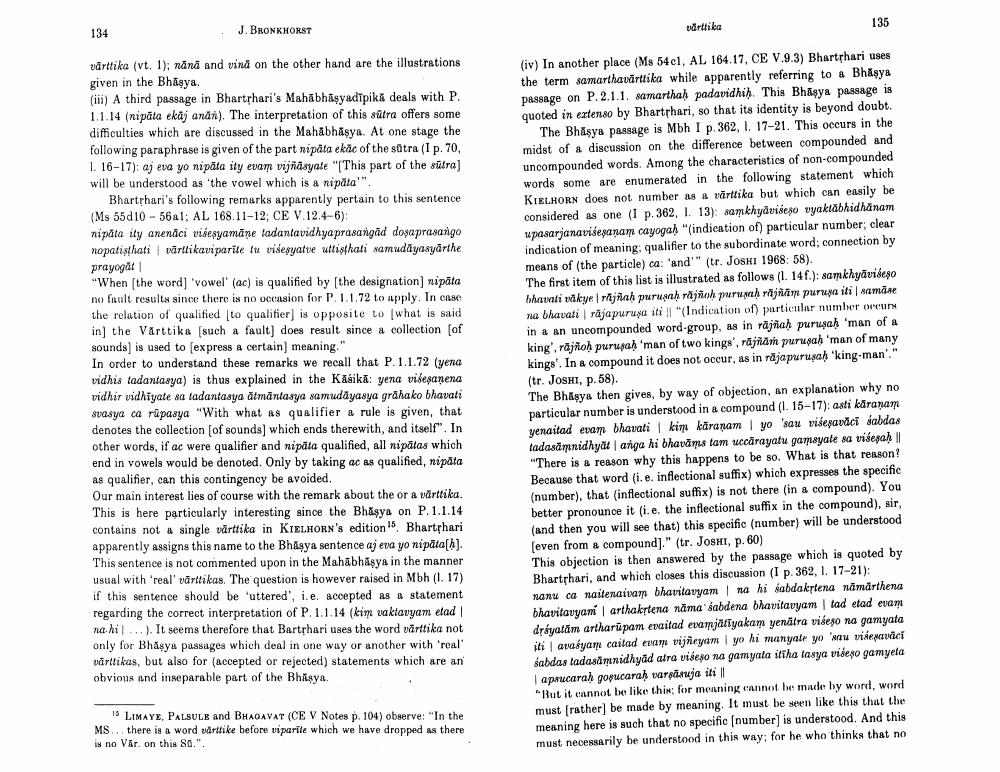Book Title: Archiv Fur Indische Philosophie Author(s): Johannes Bronkhorst Publisher: Johannes Bronkhorst View full book textPage 7
________________ 134 J. BRONKHORST vārttika (vt. 1); nānā and vină on the other hand are the illustrations given in the Bhasya. (iii) A third passage in Bhartṛhari's Mahabhaṣyadīpika deals with P. 1.1.14 (nipata ekaj anan). The interpretation of this sütra offers some. difficulties which are discussed in the Mahabhaṣya. At one stage the following paraphrase is given of the part nipäta ekac of the sutra (I p. 70, 1. 16-17): aj eva yo nipata ity evam vijñāsyate "[This part of the sutra] will be understood as 'the vowel which is a nipăta"". Bhartṛhari's following remarks apparently pertain to this sentence (Ms 55d1056a1; AL 168.11-12; CE V.12.4-6): nipata ity anenaci višeşyamane tadantavidhyaprasangad doṣaprasango nopatisthati värtlikaviparite tu viseşyatve uttisthati samudayasyarthe prayogat | "When [the word] 'vowel' (ac) is qualified by [the designation] nipata no fault results since there is no occasion for P. 1.1.72 to apply. In case the relation of qualified [to qualifier] is opposite to [what is said. in] the Varttika [such a fault] does result since a collection [of sounds] is used to [express a certain] meaning." In order to understand these remarks we recall that P. 1.1.72 (yena vidhis tadantasya) is thus explained in the Käsika: yena višeṣaṇena vidhir vidhiyate sa tadantasya ätmäntasya samudayasya grahako bhavati svasya ca rupasya "With what as qualifier a rule is given, that denotes the collection [of sounds] which ends therewith, and itself". In other words, if ac were qualifier and nipata qualified, all nipatas which end in vowels would be denoted. Only by taking ac as qualified, nipăta as qualifier, can this contingency be avoided. Our main interest lies of course with the remark about the or a varttika. This is here particularly interesting since the Bhasya on P. 1.1.14 contains not a single värttika in KIELHORN's edition 15. Bhartṛhari apparently assigns this name to the Bhasya sentence aj eva yo nipata[b]. This sentence is not commented upon in the Mahabhaṣya in the manner usual with 'real' varttikas. The question is however raised in Mbh (1. 17) if this sentence should be uttered', i.e. accepted as a statement regarding the correct interpretation of P. 1.1.14 (kim vaktavyam etad na hil.). It seems therefore that Bartṛhari uses the word värttika not only for Bhasya passages which deal in one way or another with 'real' vārtikas, but also for (accepted or rejected) statements which are an obvious and inseparable part of the Bhāṣya. 15 LIMAYE, PALSULE and BHAGAVAT (CE V Notes p. 104) observe: "In the MS... there is a word värttike before viparite which we have dropped as there is no Vär. on this S0.". värttika 135 (iv) In another place (Ms 54c1, AL 164.17, CE V.9.3) Bhartṛhari uses the term samarthavärttika while apparently referring to a Bhasya passage on P.2.1.1. samarthaḥ padavidhiḥ. This Bhasya passage is quoted in extenso by Bhartṛhari, so that its identity is beyond doubt.. The Bhasya passage is Mbh I p. 362, 1. 17-21. This occurs in the midst of a discussion on the difference between compounded and uncompounded words. Among the characteristics of non-compounded words some are enumerated in the following statement which KIELHORN does not number as a varttika but which can easily be considered as one (I p. 362, 1. 13): samkhyāvisezo vyaktabhidhanam upasarjanavisesanam cayogaḥ "(indication of) particular number; clear indication of meaning: qualifier to the subordinate word; connection by means of (the particle) ca: 'and'" (tr. JOSHI 1968: 58). The first item of this list is illustrated as follows (1. 14f.): samkhyāviseso bhavati vakye | rajñaḥ purusaḥ rajñoh purusaḥ rajñām purusa iti | samase na bhavati rajapuruşa iti | "(Indication of) particular number occurs in a an uncompounded word-group, as in rajñaḥ puruṣaḥ 'man of a king', rajñoḥ purusaḥ 'man of two kings', räjñām puruṣaḥ 'man of many kings'. In a compound it does not occur, as in rajapuruṣaḥ 'king-man'." (tr. JOSHI, p. 58). The Bhasya then gives, by way of objection, an explanation why no particular number is understood in a compound (1. 15-17): asti käraṇam yenaitad evam bhavati | kim karanam | yo sau višesavāci sabdas tadasāmnidhyat anga hi bhavams tam uccarayatu gamsyate sa visesaḥ || "There is a reason why this happens to be so. What is that reason? Because that word (i. e. inflectional suffix) which expresses the specific (number), that (inflectional suffix) is not there (in a compound). You better pronounce it (i.e. the inflectional suffix in the compound), sir, (and then you will see that) this specific (number) will be understood [even from a compound]." (tr. JOSHI, p. 60) This objection is then answered by the passage which is quoted by Bhartṛhari, and which closes this discussion (I p. 362, 1. 17-21): nanu ca naitenaivam bhavitavyam na hi sabdakṛtena nämärthena bhavitavyam | arthakṛtena näma sabdena bhavitavyam | tad etad evam dréyatām artharupam evaitad evamjatiyakam yenätra viseso na gamyata iti | avaiyam caitad evam vijñeyam | yo hi manyate yo 'sau viseṣavācī sabdas tadasamnidhyad atra viseso na gamyata itiha tasya višeşo gamyeta |apsucaraḥ gosucaraḥ varsasuja iti || "But it cannot be like this: for meaning cannot be made by word, word must [rather] be made by meaning. It must be seen like this that the meaning here is such that no specific [number] is understood. And this must necessarily be understood in this way; for he who thinks that noPage Navigation
1 ... 5 6 7 8 9 10 11 12 13
